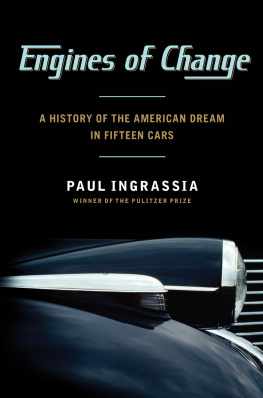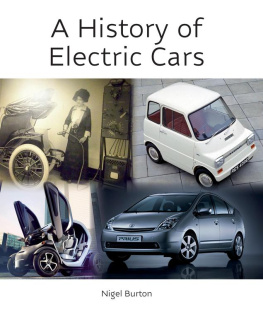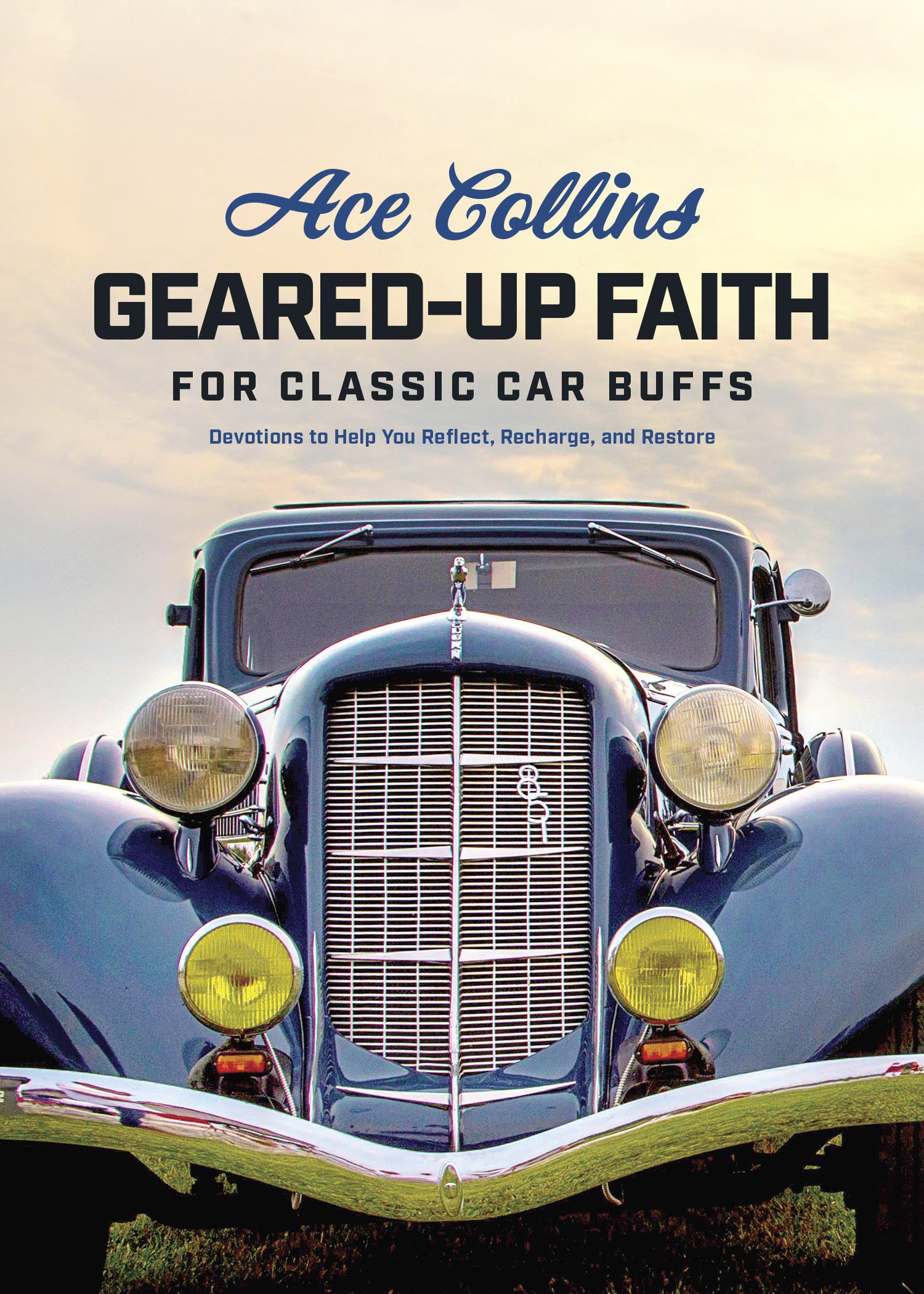Visit Tyndale online at tyndale.com.
Tyndale, Tyndales quill logo, Living Expressions, and the Living Expressions logo are registered trademarks of Tyndale House Ministries.
Geared-Up Faith for Classic Car Buffs: Devotions to Help You Reflect, Recharge, and Restore
Copyright 2022 by Ace Collins. All rights reserved.
Cover photograph of 1935 Auburn copyright David Turner. Interior photographs of cars provided by the author and used with permission. Details about the images and their respective photographers are noted on pages 18590. Unless otherwise noted, interior images are the property of their respective copyright holders from Depositphotos, and all rights are reserved. Text divider copyright S-E-R-G-O; leather background copyright chuckchee; tool symbols copyright panambapro; cogwheels copyright sergeyskleznev; lozenges pattern copyright VadimVasenin; red Chevrolet Stovebolt Six copyright Manfred Gottschalk/Getty; 1932 Model B Ford V-8 copyright falun/iStockphoto; 1953 Chevrolet Corvette copyright FernandoV/Shutterstock.
Designed by Ron C. Kaufmann
Scripture quotations are taken from the Holy Bible, New Living Translation, copyright 1996, 2004, 2015 by Tyndale House Foundation. Used by permission of Tyndale House Publishers, Carol Stream, Illinois 60188. All rights reserved.
For information about special discounts for bulk purchases, please contact Tyndale House Publishers at , or call 1-855-277-9400.
ISBN 978-1-4964-5614-4
Build: 2022-03-30 15:34:13 EPUB 3.0
Introduction
L EGENDARY CARS INSPIRE legendary stories, whether theyre generated by the manufacturers or individual owners. Separating fact from fiction in the automotive world is often difficultif not impossible.
A clear example is the myriad of stories claiming to fully identify why a Jeep is called a Jeep. The truth is this: The answer has never been satisfactorily defined.
Even within the well-documented history of the Ford Motor Company, there are still debates about whether it was Henry or Edsel who came up with certain ideas and put them into motion.
And when it comes to actual sales figures of car models, the totals are often called into question due to differing accounting policies at various companies.
No one would argue that within a decade of the horseless carriages debut, the car was the most recognized symbol of the industrial and mechanical age. The automotive industry was also one of the primary forces in the advancement of technology and offered that technology to everyone. Cars and trucks spurred American growth by hauling people and products everywhere, and soon the United States became a power player on the world stage.
The men behind the cars possessed creative genius and deeply rooted determination, but they were also flawed. And just like all of us, they were sometimes shortsighted and misguided. Yet through their work they united countless people from different backgrounds and cultures. For that, we owe them dearly.
Thanks to a crack team of fact-checkers coupled with scores of interviews, we have attempted to separate reality from myth and present history as it unfolded. The photos Ive included have either been taken recently or gleaned from historical archives, all of them chosen so you could fully visualize the cars that have enthralled collectors for decades.
Ive enjoyed every aspect of this project, but to me the most important part of this book is the Spiritual Tune-Up at the end of each chapter. My hope is each one will steer you toward service, growth, and spiritual knowledge. Enjoy the stories, admire the cars, and share them with others.
Special thanks to the car clubs, museums, historians, and private owners who helped me put this work into motion. Without them, the project could not have been completed.
And on a personal note, I want to remember my grandfather, Tom Shell, who planted in me a fascination with the automotive world. Thanks, Grandpa!
If you dont see your favorite make or model in the book, perhaps there will be another collection of stories down the road. God bless, and happy motoring!
Ace Collins
CHAPTER 1 : The Goodyear Tire & Rubber Company
More People Ride on Goodyear Tires than on Any Other Kind

The King will say to those on his right,... Inherit the Kingdom prepared for you from the creation of the world. For I was hungry, and you fed me. I was thirsty, and you gave me a drink. I was a stranger, and you invited me into your home. I was naked, and you gave me clothing. I was sick, and you cared for me.... Then these righteous ones will reply, Lord, when did we ever see you hungry and feed you? Or thirsty and give you something to drink? Or a stranger and show you hospitality? Or naked and give you clothing? When did we ever see you sick or in prison and visit you? And the King will say,... When you did it to one of the least of these my brothers and sisters, you were doing it to me!
MATTHEW 25:34-40
DRIVING THE STORY
Charles Goodyear, a man who never imagined, much less built, a horseless carriage, is as important to the success of the automobile as were Henry Ford, Louis Chevrolet, and Walter Chrysler. Some would even argue that without this inventor, the car as we know it might have never gotten on the road. Yet Charles Goodyears life was filled with sadness, despair, and rejection, not triumph and acclaim.
Goodyear was born in 1800 in New Haven, Connecticut. His father, Amasa, was a blacksmith and button maker who started an agricultural-hardware retail business. After returning from business school, Charles became the sales manager. The family did well for a number of years, even expanding into other states. But their system of extending credit to farmers, coupled with money being tied up in real estate investments and inventions, eventually doomed the business. Customers werent paying their bills, and creditors came collecting. Awash in debt, Charles turned all his attention to inventions, hoping to recoup funds and appease the creditors. But in the early 1830s, Goodyear was sent to debtors prison for a time.
When he was released, Goodyear became interested in the potential of something most people thought was little more than a nuisanceIndia rubber. Raw rubber was hard to work with, and those who were able to utilize it in some form, such as Scotsman Charles Macintosh did with his waterproof garments, were the exceptions. But Goodyear was convinced rubber was the key to his familys future and set up shop in the kitchen. He procured an investor to underwrite the experiments. One day, Goodyear inadvertently discovered that incorporating nitric acid made rubber smoother and less sticky, a process he patented. Encouraged by the progress, in 1837 Goodyear took on a partner with funds: William F. Ely. They rented space at the Roxbury India Rubber Company in Massachusetts, which was also trying to unlock the mystery of making rubber a viable material to use in manufacturing.
A man named Nathaniel Hayward was attempting the same thing and getting closer to the solutioncuring rubber with sulfur. Hayward had worked for the Eagle India Rubber Company and bought it out in 1837. Two former Roxbury stockholders were aware of Haywards rubber products and compelled Goodyear to try and strike a deal. Hayward refused to sell his company, but he did send a sheet of untreated rubber to Goodyear, keeping his chemical secret secure.














